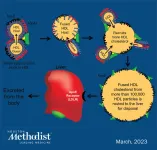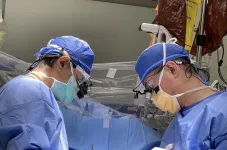Altered “neuronal avalanches” in brains of epilepsy patients tied to cognitive performance
2023-03-15
(Press-News.org) New research by the Human Brain Project has found that in the brains of patients with epilepsy, changes in large scale neuronal activations can be detected in the brain’s resting state activity, even when no seizure is ongoing. The non-invasive approach could lead to a new method to aid epilepsy diagnostics.
Diagnosing epilepsy can be problematic for patients, who sometimes have to wear helmets and electrodes for prolonged periods of time waiting for an epileptic episode to happen, so that the clinicians can document it with EEG. Alternatively, the seizure is artificially induced, causing discomfort.
The new findings stem from a collaboration between the Institut de Neurosciences des Systèmes (France), the IRCCS E.Medea - La Nostra Famiglia (Italy) and the Department of General Psychology of Padua University (Italy). Published in the journal Epilepsia, the study has compared high density electroencephalograms (EEG) of 37 patients with temporal lobe epilepsy with healthy controls.
While the brain is at rest, spontaneous waves of neuronal activation are constantly generated. Their function is not fully understood, but they seem to play an important part in brain functionality. The researchers demonstrated that even during resting state it is possible to detect an alteration of the propagation patterns of so-called large-scale “neuronal avalanches”, suggesting a potential diagnostic application in epilepsy. These neuronal avalanches are triggered by the spontaneous activation of a group of neurons that then spreads across large areas of the brain, in a cascade effect.
"Our new method is capable of detecting relevant features of epilepsy by simply taking into account the basal functional organisation of the brain” explain Gian Marco Duma and Pierpaolo Sorrentino, respectively researchers at IRCCS E.Medea and the Institut de Neurosciences des Systèmes in Marseille, who collaborated on this study. “Even while a seizure is not happening, the brain of a patient with epilepsy presents some alterations in its network dynamics at the whole-brain scale. So we thought it would be possible to examine the dynamics by looking at aperiodical, spontaneous neuronal avalanches”.
“We found that the alteration of the spreading of neuronal avalanches in temporal lobe epilepsy is clustered around those brain areas which are fundamental for seizure initiation and diffusion” say Duma and Sorrentino. “This opens up the possibility to a new preliminary diagnostic method, especially important for the difficult cases where scalp EEG fails to detect seizures and additional investigations are necessary”.
The results also detected a link between the alteration of the spreading of neuronal avalanche and memory, which is often impaired in patients with epilepsy. The temporal lobe is specifically associated with memorisation, and specific patterns of propagation at resting state could be altered by epilepsy. “This finding offers us further evidence of the neurophysiological and neuropsychological relevance of neuronal avalanches” suggest the researchers.
Text by Roberto Inchingolo
END
ELSE PRESS RELEASES FROM THIS DATE:
2023-03-15
A new study has found evidence of cheesemaking, using milk from multiple animals in Late Neolithic Poland.
The research suggests that early farmers reduced the lactose content in milk by making it into cheese or other dairy products like yoghurt, and used dairy products from a number of different animals, such as cows, sheep or goats.
Lactose intolerance was a common condition in almost everyone in Europe during the Neolithic and until the Late Bronze Age when the genetic mutation became widespread, enabling adults to produce lactase, the enzyme which breaks down lactose in the body.
Researchers looked at the practice of dairy processing ...
2023-03-15
Community health workers can make a great difference in increasing the number of pregnant women who receive life-saving preventive antimalarial treatment, according to a study conducted in four sub-Saharan African countries and led by the Barcelona Institute for Global Health (ISGlobal), an institution supported by “la Caixa” Foundation. The findings, published in The Lancet Global Health, will help to guide malaria control strategies in pregnant women and improve maternal and infant health in malaria-endemic ...
2023-03-15
Robots can be useful as mental wellbeing coaches in the workplace – but perception of their effectiveness depends in large part on what the robot looks like.
Researchers from the University of Cambridge carried out a study in a tech consultancy firm using two different robot wellbeing coaches, where 26 employees participated in weekly robot-led wellbeing sessions for four weeks. Although the robots had identical voices, facial expressions, and scripts for the sessions, the robots’ physical appearance affected how participants interacted with it.
Participants who did their wellbeing exercises with a toy-like robot said that they felt more of a connection ...
2023-03-15
Wildlife documentaries miss an opportunity to highlight the diversity of nature by focusing too much on mammals and birds, according to a new study.
In a new study published in People and Nature, researchers from the University of Cambridge have shown that while the production of wildlife documentaries has exploded over recent decades, they portray a biased view of the natural world around us.
Our natural world is under threat, from habitat and biodiversity loss, to high extinction rates. At the same time, there is a growing disconnect between people and nature, with children’s opportunities to experience the natural world diminishing.
Now more ...
2023-03-15
Electrification is seen as having an important role to play in the fossil-free aviation of tomorrow. But electric aviation is battling a trade-off dilemma: the more energy-efficient an electric aircraft is, the noisier it gets. Now, researchers at Chalmers University of Technology, Sweden, have developed a propeller design optimisation method that paves the way for quiet, efficient electric aviation.
In recent years, electrification has been described as having an important role in reducing emissions from future aviation. Due to the challenges posed by longer ranges, interest is chiefly focused on electric propeller planes covering shorter distances. Propellers connected to ...
2023-03-14
A new demographic survey of authorship in the American Journal of Archaeology (AJA) reveals that people of color have been largely underrepresented among the scholars published in the journal. The results of the survey, which also found that authors who are the children of people without advanced degrees were also underrepresented in the journal’s pages, are published in the paper “Demographic Dynamics of Publishing in the American Journal of Archaeology.” The study was conducted ...
2023-03-14
During the pandemic, medical doctors and researchers noticed that children and adolescents infected with COVID-19 became less ill than adults. A possible explanation for this is that children already had a prior level of immunity to COVID-19 provided by memory T cells generated by common colds.
After studying unique blood samples from children taken before the pandemic, researchers from Karolinska Institutet in Sweden have now identified memory T cells that react to cells infected with SARS-CoV-2, the virus that causes COVID-19.
Four coronaviruses cause common colds
A possible explanation for this immunity in children is that they already had colds caused by one of the four coronaviruses ...
2023-03-14
Houston Methodist scientists reversed infertility in sterile mice by reducing high-circulating cholesterol with a bacterial protein, showing further evidence that links high cholesterol to female infertility. This is a promising development, with one in every five women of childbearing age in the U.S. unable to get pregnant after trying for a year.
“We are working with a protein, called serum opacity factor, with unique characteristics,” said Corina Rosales, Ph.D., assistant research professor of molecular biology in medicine with the Houston Methodist ...
2023-03-14
LEXINGTON, Ky. (March 14, 2023) — The lung transplant team at UK HealthCare’s Transplant Center recently celebrated a major milestone, performing the 500th lung transplant since the lung transplant program was founded in 1991.
“This is an impressive milestone, and our whole staff — physicians, surgeons, nurse practitioners, nurse coordinators, pharmacists, nutritionists, social workers, therapists and support staff — should be very proud of their success,” said Sravanthi Nandavaram, M.D., medical director of the Lung Transplant Program. ...
2023-03-14
Since the development of functional magnetic resonance imaging in the 1990s, the reliance on neuroimaging has skyrocketed as researchers investigate how fMRI data from the brain at rest, and anatomical brain structure itself, can be used to predict individual traits, such as depression, cognitive decline, and brain disorders.
Brain imaging has the potential to reveal the neural underpinnings of many traits, from disorders like depression and chronic widespread pain to why one person has a better memory than another, and why some people’s memories are resilient as they age. But how reliable brain imaging is for detecting traits has been a subject of wide debate.
Prior research ...
LAST 30 PRESS RELEASES:
[Press-News.org] Altered “neuronal avalanches” in brains of epilepsy patients tied to cognitive performance




